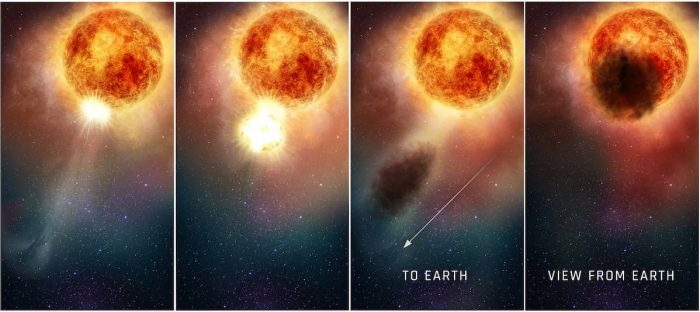Did you know that the star Betelgeuse is 1400 times bigger than our sun?
Discover some interesting facts about the betelgeuse star. In our impressive universe we see inanimate things that fascinate us, like the stars, which, when contemplating them on a night, left us without food.
Our perception of the sun is the biggest star, but it is well known that there are much bigger stars, such as the star Betelgeuse, the famous red star of the constellation of Orion. Did you know that it is 1400 times bigger than the sun?
If the star Betelgeuse were in the center of our solar system, it would extend between the orbit of Mars and that of Jupiter. It is extremely huge. Of the supergiant stars, this is the biggest that can be seen without a telescope

ALMA (ESO/NAOJ/NRAO)/E. O’Gorman/P. Kervella
How far is it from us? It’s 530 light years away, and that’s why it doesn’t look so big. Its light takes 530 years to reach Earth, so we can see it as it was five years ago. If you see it at first glance, you will notice that it is red in color and not white.
Betelgeuse is 25% closer to Earth than believed and is smaller
For a long time it was estimated that the star was 650 light years from our planet.
In 2020, an international team of scientists discovered that the Earth is 25% closer to Earth than previously thought, in fact it is relatively smaller.
Esto tiene logic pues, the greater the distance from Earth, the smaller you see. If it is closer, 530 light years from Earth, it means that the size it was thought to have was not correct.
In a statement the Dr. László Molnár said the following:
«The actual physical size of Betelgeuse has been a mystery, previous studies have suggested that it could be larger than the orbit of Jupiter. Our results indicate that Betelgeuse only extends to two thirds of the Sun, with a radio of 750 times the radio of the Sun».
Once we saw the physical size of the star, we could determine the distance from Earth. Our results show that it is only 530 years old, 25 percent more than what was thought.Dr. László Molnár, co-author of the study
Links: astronoo.com | blogodisea.comThe mystery of why Betelgeuse darkened in 2020
In 2020, the star Betelgeuse dimmed a little, unleashing theories of what happened. ¿Pero que fue lo pasó en realidad?
The star ‘tosió’ an octopus cloud. The dimming of the star Betelgeuse, one of the brightest of the night sky, could have an explanation: the star ‘tosió’ an octopus cloud, said astronomers.
Yes, astronomers were worried about the sudden darkening of the star Betelgeuse. Some thought it was about to explode, while others suggested it was a cosmic octopus launched from the same star.
Betelgeuse has dimmed since autumn 2019 and returned to its normal brightness in May 2020. This in turn has provoked new speculations about the cause of the dimming. Some scientists thought that it was a cloud of octopus that blocked the light, while others said that it was a question of large stellar spots on the surface of Betelgeuse.
The star expelled plasma that became an octopus

The star Betelgeuse expelled an octopus cloud
A giant stellar eruption. The researchers studied the star with the Hubble telescope and saw a clearer image. I could see how the super hot plasma is expelled from the surface of the star, cools down in the outer layers of the atmosphere and finally turns into an octopus.
Said material moved in the atmosphere at extreme speeds, around 320,000 km / h, which is equal to 88,888 meters per second. Impressive!
Why did this happen? Investigators said they are not sure what caused the star’s plasma explosion.
[Space.com, Science Alert]
Betelgeuse turned off for the second time but this time it was due to pulsations of the star. Read more why betelgeuse is going out.
For sure you don’t lose what is the biggest star in the universe and the curiosities of Antares, a giant red star.
What do these curious facts about Betelgeuse look like to you?


